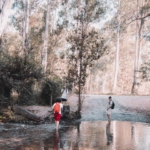
06 Apr How Kids Can Start and Document a Nature Collection
Nature play can be a very enjoyable, relaxing and adventurous activity for kids (oh – and it’s free!). So why not get them outdoors exploring and learning about nature? We share some tips on how they can start, and record their findings!
What to include in your Collector’s Kit.
Before you start making your environmental discoveries, you will need to put a Collector’s Kit together.
Here are a few things to include in your Collector’s Kit:
- Sunscreen, sunglasses, and a hat: shell collecting is fun but sunburn is not!
- Sandals, sneakers, or bare feet? If you are walking on rocks and looking in tidal pools, wear an old pair of sandals or sneakers you don’t mind getting wet. Rocks on the shore can be slippery and broken shells can cause cuts, so be careful where you place your feet. On sandy beaches, nothing beats walking barefoot.
- A bucket or basket and sandwich bags: a small plastic bucket will make carrying your treasures easier. Sandwich bags help protect fragile specimens.
- A small hand rake is useful when looking through seaweed, reaching into cracks in rocks, or digging out partially buried shells from the sand.
- A notebook is a good idea if you want to record information about the shells you collect.
How to start a seashell collection.
One of the simplest things you can collect are seashells. There are good times to collect shells – and then there are great times!
After a storm:
Seashells wash up on beaches after a storm. Look in tidal pools and between
rocks. You’ll also find shells by gently pulling apart clumps of seaweed.
Low tides:
Low tides happen twice a day, and on a new or full moon tides are extra low and more sand is exposed. Those are the times you can collect shells that don’t often show up on the beach.
Morning:
Be an early bird. Shells wash onto shore at night and, if you are out before anyone else, you are more likely to find the best.
Remember to be a conscientious collector.
Keep these important environmental points in mind when going on shell collection hunts.
- Collect only dead shells; make sure there is no animal living in a shell that you pick up. Keep your eyes open for hermit crabs: remember that animals other than the one that made the shell might be using it for a home.
- Take only as many shells as you need for your collection, and perhaps a few more to trade with friends.
- Check to see whether there are any local rules that prohibit collection of shells. In some places, beaches and tidal pools are protected, and visitors are not allowed to keep even dead shells.

How to start a nature journal.
Now that you have your nature collection, you can now begin documenting your findings in a journal or notebook.
One of the best ways to practise your curatorial skills is to keep a field notebook where you can write down your
observations of nature and the specimens you collect. Of course, you can keep track of your field notes and photos digitally, but you might find it particularly satisfying to maintain your records in a binder. (Or if you collect several different types of things – like plants and rocks – you might want a separate binder for each!).
There’s definitely something special about being able to sit at your desk and page through a book about your favourite subject that you’ve written and illustrated yourself. If you also jot down notes about some of the adventures you experience on your collecting forays, the book will double as a journal of where you’ve been, what you’ve done, and when it happened.
Although any kind of notebook will work, a three-ring binder is especially useful. Many have plastic covers that can be wiped clean and the binder will allow you to remove pages and add new ones. Because they are available in many thicknesses, you can keep a thin one in your backpack and then transfer the day’s pages to a thicker binder when you get home.
On a visit to a stationary or art supply shop – in person or online – you’ll discover that there are many useful inserts available for a collector’s notebook. There’s lined paper for notes, of course, plain paper for drawings and sketches, graph paper for charts, and tabbed dividers to mark the different sections. All of these are available with the holes pre-punched.
Making drawings of specimens on-site, and then finishing them at home, will help train your eye to observe nature closely –and will polish up your drawing skills!
Happy collecting and documenting!
For more outdoor activities and ideas click here.
We also have a FREE downloadable Nature mini-magazine filled with more fun nature play ideas! Download your copy HERE.
 This is an edited extract from Natural History Collector: Hunt, Discover, Learn! by Michael Sanchez, Murdoch Books, it’s $24.99 and available in stores nationally.
This is an edited extract from Natural History Collector: Hunt, Discover, Learn! by Michael Sanchez, Murdoch Books, it’s $24.99 and available in stores nationally.
Photography by Annie Spratt + Catrin Johnson.





